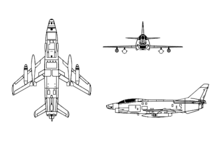Fiat G.91Y
| G.91Y | |
|---|---|

| |
| A G91Y at Bremgarten in September 1992 | |
| Role | Ground attack |
| National origin | Italy |
| Manufacturer | Fiat Aviazione Aeritalia |
| First flight | 27 December 1966 |
| Introduction | July 1968 |
| Retired | 1994 |
| Primary user | Italian Air Force |
| Produced | 1966-1972 |
| Number built | 2 prototypes + 65[1] |
| Developed from | Fiat G.91 |

The Fiat (later Aeritalia) G.91Y is an Italian ground-attack and reconnaissance aircraft which first flew in 1966. Although resembling its predecessor, the Fiat G.91, the aircraft was in fact a complete redesign, a major difference being that it was equipped with a new twin-engine configuration, replacing the original single engine.
Design and development
The G.91Y was an increased-performance version of the Fiat G.91 funded by the Italian government. Based on the G.91T two-seat trainer variant, the single Bristol Orpheus turbojet engine of this aircraft was replaced by two afterburning General Electric J85 turbojets which increased thrust by 60% over the single-engined variant.[2] Structural modifications to reduce airframe weight increased performance further and an additional fuel tank occupying the space of the G.91T's rear seat provided extra range. Combat manoeuvrability was improved with the addition of automatic leading edge slats.[2]
The avionics equipment of the G.91Y was considerably upgraded with many of the American, British and Canadian systems being licence-manufactured in Italy.[2]
Flight testing of three pre-production aircraft was successful, with one aircraft reaching a maximum speed of Mach 0.98. Airframe buffeting was noted and subsequently rectified in production aircraft by raising the position of the tailplane slightly.
Production
An initial order of 55 aircraft for the Italian Air Force was completed by Fiat in March 1971, by which time the company had changed its name to Aeritalia (from 1969, when Fiat aviazione merged with Aerfer). The order was increased to 75 aircraft with 67 eventually being delivered. In fact, the development of the new G.91Y was quite long, with the first order being for about 20 pre-series examples that followed the two prototypes. The first pre-series 'Yankee' (the nickname of the new aircraft) flew in July 1968.
AMI (Italian Air Force) placed orders for two batches; 35 fighters followed by another 20, later cut to 10. The last one was delivered around mid 1976, making a total of two prototypes, 20 pre-series and 45 series aircraft. No export success followed. These aircraft served with 101° Gruppo/8° Stormo (Cervia-S.Giorgio) from 1970, and later, from 1974, they served with the 13° Gruppo/32° Stormo (Brindisi).[3] Those 'Gruppi' (Italian equivalent of British 'squadrons', usually equipped with 18 aircraft) lasted until the early '90s, as the only ones equipped with the 'Yankee', using them as attack/reconnaissance machines, both over ground and sea, until the AMX replaced them.
Variants
- G.91Y - Prototype and production aircraft.
- G.91YT - Projected two-seat trainer variant.[4]
- G.91YS - Prototype with enhanced avionics and extra hardpoints to carry AIM-9 Sidewinder missiles for evaluation by Switzerland. First flown on 16 October 1970.[4][5]
Operators
- Italian Air Force operated 65 Fiat G.91Ys until 1994
Aircraft on display
- A Fiat G.91Y is preserved and on public display at the Italian Air Force Museum, Vigna di Valle.[6]
- A Fiat G.91Y is the gate guardian at the Antonio Locatelli High school in Bergamo, Italy.[7]
Specifications (G.91Y)

Data from The Observer's Book of Aircraft.[4]
General characteristics
- Crew: 1
- Length: 11.67 m (38 ft 3 in)
- Wingspan: 9.01 m (29 ft 7 in)
- Height: 4.43 m (14 ft 6 in)
- Wing area: 18.13 m2 (195.1 sq ft)
- Airfoil: root: NACA 65A112; tip: NACA 65A111[8]
- Empty weight: 3,900 kg (8,598 lb)
- Gross weight: 7,800 kg (17,196 lb)
- Max takeoff weight: 8,700 kg (19,180 lb) max overload
- Powerplant: 2 × General Electric J85-GE-13A afterburning turbojet engines, 12.12 kN (2,725 lbf) thrust each dry, 18.15 kN (4,080 lbf) with afterburner
Performance
- Maximum speed: 1,110 km/h (690 mph, 600 kn) at sea level
- Maximum speed: Mach 0.95 at 10,000 m (32,800 ft)
- Cruise speed: 630 km/h (390 mph, 340 kn)
- Ferry range: 3,400 km (2,100 mi, 1,800 nmi) with drop tanks
- Service ceiling: 12,500 m (41,000 ft)
- Rate of climb: 86 m/s (17,000 ft/min)
- Wing loading: 480 kg/m2 (98 lb/sq ft)
- Thrust/weight: 0.43
Armament
- Guns: 2 × 30 mm (1.18 in) DEFA cannons
- Hardpoints: 4 under-wing pylon stations with a capacity of 1,814 kg (4,000 lb)
See also
Related development
Aircraft of comparable role, configuration, and era
Related lists
References
Notes
- ^ "None". Retrieved 1 April 2023.
- ^ a b c [Staff author] 20 June 1968. "Fiat G.91Y" Flight International, p. 931. www.flightglobal.com. Retrieved: 30 December 2011.
- ^ Warplanes encyclopedia, Aerospace Publishing, 1984, Italian version print by De Agostini, 1985, p.16
- ^ a b c Green 1972, p. 8.
- ^ [Staff author] 29 April 1971. "Italy's aircraft industry" Flight International, p. 578. www.flightglobal.com. Retrieved: 30 December 2011.
- ^ Italian Air Force Museum - Fiat G.91Y factsheet Archived 24 December 2011 at the Wayback Machine www.aeronautica.difesa.it. Retrieved: 31 December 2011
- ^ Fiat G.91Y image static.wixstatic.com Retrieved 1 April 2023
- ^ Lednicer, David. "The Incomplete Guide to Airfoil Usage". m-selig.ae.illinois.edu. Retrieved 16 April 2019.
Bibliography
- Green, William. The Observer's Book of Aircraft. London. Frederick Warne & Co. Ltd., 1972. ISBN 0-7232-1507-3
